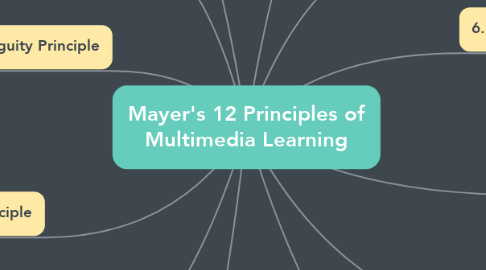
1. 3.Signalling Principle
1.1. highlight the organization of the essential materials
1.2. advantages
1.2.1. helps to direct the audience's eye
1.2.2. easily locate what & how information related to the graphic
2. 4.Redundancy Principle
2.1. use graphic & narration/ x not graphic, narration & printed text
2.2. advantage
2.2.1. helpful in presenting ideas to the audiences
3. 5. Spatial Contiguity Principle
3.1. place words & pictures near each other
3.2. advantages
3.2.1. indicates the relationship
3.2.2. reduce the demand placed
3.2.3. reduce load on working memory
4. 7. Segmenting principle
4.1. breaking down the large segments into smaller segments by providing learner 'next' button.
4.2. advantages
4.2.1. better way in transfer information
4.2.2. allows learner to engage without overloading cognitive system.
5. 9. Personalization principle
5.1. humans learn best from a more informal voice than an overly formal voice
5.2. learning experience will be more improved by keeping the language simple and casual.
5.3. advantage
5.3.1. enhance personalization of the audience
6. 11. Image principle
6.1. humans do not necessarily learn better from a talking head video.
6.2. relevant animations and visuals been used more than talking and speech from speaker
6.3. advantage
6.3.1. boring
7. 1.Multimedia Principle
7.1. use words & pictures instead of words alone
7.2. advantages
7.2.1. to support learning
7.2.2. reinforces the content & improve knowledge transfer
7.2.3. impacful content
8. 2.Coherence Principle
8.1. exclude extraneous materials
8.1.1. distracting the learners
8.1.2. decrease the learning
9. 6. Temporal Contiguity Principle
9.1. present corresponding words & pictures at the same time
9.2. the narration or spoken presentation need to happen at the same time with related graphic or graphic appear
10. 8. Modality principle
10.1. limit the text used and rely on visuals instead
10.2. humans learn best from visuals and spoken words than from visuals and printed words.
10.3. advantage
10.3.1. learners will be overwhelmed
11. 10. Voice principle
11.1. humans learn best from a human voice than a computer voice
11.2. advantage
11.2.1. audience will feel more real and close
12. 12. Pre-training
12.1. humans learn more efficiently if they already know some of the basics.
12.2. highlight on understanding basic definitions, terms, or concepts before beginning the learning experience
12.3. advantages:
12.3.1. easily become overwhelmed and get excited
12.3.2. easily process the information
